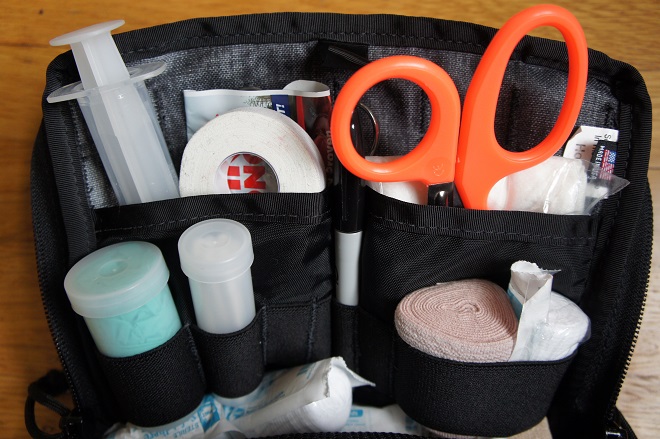The Basics of Building an Awesome First Aid Kit
You know, it’s a shame we all aren’t as excited about first aid kits as we are about packs! Our personal wellbeing is paramount to getting out and doing what it is that we love, so why not get hyped about first aid? For one it’s not very glamorous, and if you’re new to first aid, putting a kit together can be a bit overwhelming. But we’re not the crowd to be intimidated by something new…we’re the crowd that has the EDC to handle whatever the day throws at us. That’s why we’re covering a basic list of what to include in your kit and what you should consider when selecting a container.

Firstly though, we should make clear that a first aid kit is not something that hangs on the wall in a glass container. It’s dynamic and versatile. Your kit should constantly be changing to address the potential issues you might face. For example, if I’m going rock climbing with friends, I’m taking an extra SAM splint, or if we are kayaking, a CPR mask. Your activity should dictate to some degree what you pack.
“…a first aid kit is not something that hangs on the wall in a glass container. It’s dynamic and versatile. Your kit should constantly be changing to address the potential issues you might face.”
The season and location, too, should influence what you are including. When I’m in the mountains, I carry a small candle and a Mylar blanket as part of an emergency hypothermia kit, but if I were doing the Grand Canyon in July, those things would get swapped for a micro fan/mister combo. Lastly, think about it on a “personal needs” level: How many in your group will be wearing contact lenses? Does anyone get heartburn easily? Is anyone on any prescriptions? Is there a diabetic in your group? It’s easy to see how the particulars of each trip will influence your loadout.
“The season and location, too, should influence what you are including.“

Once we’ve figured out where we are in regard to potential issues, we are going to create a supply list and really stay on top of keeping the kit up to date and fully stocked. The last thing any of us wants is to arrive on scene with our kit and first aid knowledge and not have any gauze, or be in the backcountry with some uncontrollable stomach bug without any loperamide. Yikes.
“…create a supply list and really stay on top of keeping the kit up to date and fully stocked.”
I have a small check list of what I carry in my kit that caters to my specific needs (contact lenses, Rx heartburn meds, etc.) so to start you off, here is a PDF version of my generic contents list. Customize it to what works for you and keep a few printed near where you store your kit and your overflow supplies. Any time you head out for an adventure, cross the items off the list and BOOM! Adventure in confidence.

What’s important when selecting the right container?
Compartmentalization
It’s a long word, but I am a huge organization freak, so for me it has to be a container that allows me to compartmentalize. I need things together and ordered in the right place.
Accessibility
Also a huge factor in a good first aid kit. If I’m going for my shears or a pressure wrap, they need to be easily eyeballed and ready to roll!
Durability
I get a lot of days in camping and hiking. So I have the elements to contend with (i.e grit and ice) and there’s always the occasional stumble or fall with a tired boot every now and then, so a piece of kit that’s ‘hard-wearing’ is important.
Lastly, if it doesn’t do at least three things it doesn’t get absorbed into permanent rotation.
“Accessibility is also a huge factor in a good med kit.“
My First Aid EDC
Daily, I find a full kit to be too much to carry, so I pare down and opt for a basic trauma kit and a basic medical array, which all fits nicely into my ever-versatile Pelican 1020. It’s been with me everywhere from the rivers of Appalachia to the peaks of the Cascades. It’s been my survival kit, my fire kit, my phone-keys-wallet box, and day-to-day as a micro first aid kit. It’s clearly seen better days, and the hinges are starting to wear, but it’s small enough that I don’t mind carrying it, and it keeps my equipment protected. The 1040 is just a little larger and probably a better do-all type case. The Pelican cases are certainly lacking in the organization department, but they more than make up for it in their accessibility and durability. The 1020 has lived in the bottom of my pack for over five years and continues to get the job done.

List of items
Trauma or nitrile gloves
Roller gauze (consider x2)
Athletic tape
Mefix breathable bandage tape
Pressure wrap
Misc. pre-prepared Band-Aids
Pain relievers (specifically Aspirin in the event of heart attack)
Antihistamine
Topical antibiotic

My Extended Kit
When I do need to carry a full kit, I grab the Kifaru 1000D Organizer, one of the few products to make it into my “frequent use closet.” The capacity lets me carry everything I might need in a backcountry emergency medical situation in a clean, robust package. If I could tell you anything about the pouch, it would be that it is extremely well made. The stitching in this is incredible.

“When I do need to carry a full kit, I grab the Kifaru 1000D Organizer, one of the few products to make it into my “frequent use closet.”

Kifaru doesn’t skimp on anything. Their reputation for constructing carry solutions for our military and the most rugged backcountry hunters is clearly present in this little 9″ x 7.5″ pouch. Excellent choices of 1000D polyurethane-coated nylon, the smoothest 8mm coil zips, stitches per inch, and interior mesh.




I fit a full loadout in the organizer minus the SAM Splint (which I carry as a stiffener in the back panel of my pack) and still have room for a field medicine guide, Mylar blanket, small candle, headlamp, and writing tools. As a bonus, when it isn’t serving me as a first aid kit, it works amazingly well as a navigation kit for my handheld, topo, compass, headlamp, flashlight, and other administrative tools that I may need in the backcountry.

List of items
Protection:
Trauma or nitrile gloves: for your and the patient’s protection
CPR mask: more effective than mouth to mouth when delivering rescue breaths and provides protection to the user from the patient’s fluids
Wound Management:
Shears: in emergencies you’ll need to do a blood check and may need to cut clothing to gain access to wounds
Forceps & Tweezers: tools used in wound cleaning and removal of debris/splinters
Scalpel/Razor: removing dead tissue
Irrigation syringe: 35-60cc for pressure cleaning wounds
Roller gauze: I like roller gauze over pre-cut because I can cut what I need and get a better fitting bandage
Pressure wrap: either ACE wrap or similar, some are self-adhesive
Tape: breathable tape for custom bandages (Mefix brand is great), athletic tape for blister control and general use, and Duct tape for blister control. Don’t take a whole roll of tape unless you need it – roll off what you need and then repackage in a way that works for you – I carry Duct tape around a pencil.
Misc. bandages: Precut, prepackaged bandages, Band-Aids
Non-adherent bandages: create a “second skin,” work great for road rash and burns
Musculoskeletal Injuries:
SAM Splint: or aluminum foam splint
Pressure wrap: ACE wrap or similar – you can improvise one out of a t-shirt in an emergency
Liquids and Medications:
Soap: clean skin, hands, etc.
Povidone Iodine: clean skin, wounds, sterilize tools, and treat water in an emergency
Topical antibiotic: clean surface wounds, pretreatment for small bandages
Antihistamines: diphenhydramine, Epi with Rx
Pain relievers: Lots of options – be aware of their side effects
Gastrointestinal: antacids, charcoal pills, loperamide
Sugar: honey packets or sugary drink mixes for low glucose
Training
Regardless of what container you choose, the most important thing is that you have the items on you and that you know how to use them. Go out and get some training: take a WFA, and if you can, a WFR.

For more medical resources and courses check with Wilderness Medical Associates International and the Wilderness Medicine Training Center.





 Carry Awards
Carry Awards Insights
Insights Liking
Liking Projects
Projects Interviews
Interviews













